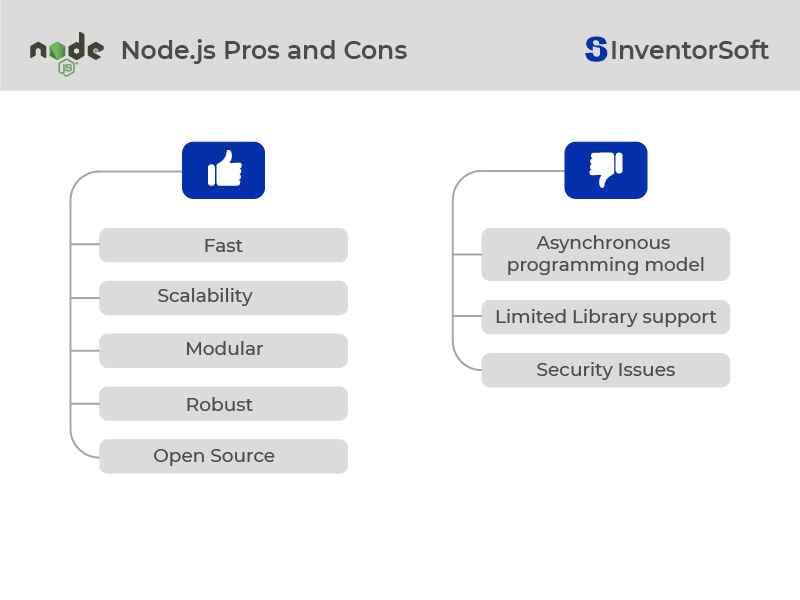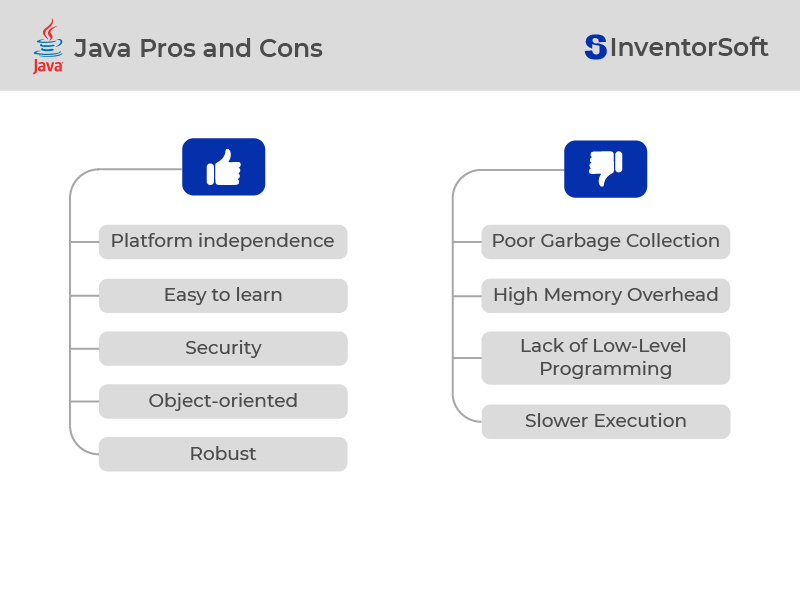
Node.js vs. Java - Which One to Choose in 2023? – InventorSoft
As businesses move online and technology advances, choosing between Node.js and Java becomes increasingly important in the programming world. Java is a powerful programming language and Node.js - is a backend tech stack for app development, with benefits and drawbacks. In this article, we will explore the pros and cons and other considerations of each language and discuss which one may be the best choice for businesses in 2023.
What is NodeJS?
Node.js is a free, accessible, cross-platform runtime environment for JavaScript that allows code execution outside a browser. Using Node.js, programmers can create command-line tools and server-side scripts that generate website content before the page is uploaded to the user's web browser. Its adoption has significantly increased leading to more companies looking to hire node.js developers.
The V8 JavaScript engine in Chrome serves as the foundation for this asynchronous event-driven JavaScript runtime. It is used to create web applications, general-purpose software, and network programs, such as gaming servers, web servers, etc. Node.js is fast, easy to use, and effective, making it the best choice for data-intensive real-time web applications, desktop apps, android apps, and mobile apps.
Use Cases of NodeJS
Node.js is used for the following:
Network applications.
IoT applications.
Data streaming applications.
Developing server-side applications and APIs.
Web applications.
Creating command-line tools and other utilities.
Building microservices and distributed systems.
Automating tasks such as minification, compilation, and testing.
Creating and deploying serverless applications.
Pros and Cons of Node.js
 Node.js has gained popularity due to its ability to create scalable, fast web applications. Below are the pros and cons of node.js:
Node.js has gained popularity due to its ability to create scalable, fast web applications. Below are the pros and cons of node.js:
Below are the pros and cons of Node.js:
Pros of Node.js
Some of the advantages of Node.js include the following;
Fast: Node.js is built on the Google V8 JavaScript engine, which is incredibly fast. This makes it ideal for applications that demand quick responses.
Scalable: Node.js is highly scalable, built on a non-blocking and event-driven I/O model. It also supports an asynchronous programming model, which makes it efficient in handling multiple simultaneous requests.
Modular: Node.js is based on a modular architecture that makes creating and maintaining large web applications easy.
Robust: Node.js has a robust library of pre-built modules, which makes it easier to develop web applications such as MongoDB, MySQL, and Redis.
Open Source: Node.js is open source, which means that it is free to use, modify, and distribute.
Integrated: Many projects are written in typescript making it easy for front-end developers to integrate backend api services on node compared to other programming languages.
Cons of Nodejs
These include:
Asynchronous Programming Model: Node.js utilizes a single-threaded, asynchronous programming model, which may not be the best choice for applications that require heavy computation.
Limited Library Support: The Node.js library ecosystem is still relatively young. Hence, it does not have as much library support as other languages, so developers may have to write more code or use external libraries.
Lack of Security Features: Node.js does not have a lot of built-in security features. Hence, developers must be extra careful when writing code and using external libraries to add security features.
Popular Companies Using Nodejs as Backend Technology
Some of the companies that use Node.js include:
Netflix
Netflix is a well-known streaming service that offers its users access to digital media and entertainment. Netflix uses Node.js to develop large-scale backend services and to power its streaming service.
Trello
Trello is a popular project management tool that uses Node.js to provide a fast, powerful, and reliable platform for its web application. With Node.js, Trello can develop a great user experience by quickly responding to user interactions with the app that provides extensive support.
Uber
Uber is a popular transportation technology company that uses Node.js as a cornerstone of its development stack. Uber builds responsive and interactive web applications with Node.js, which improves its user experience.
What is Java?
Java is one of the most popular programming languages for web development. It is an object-oriented language with a syntax comparable to C and C++. Java is a platform-independent programming language that can run on any operating system as long as the Java Runtime Environment (JRE) is installed.
It is employed to develop various applications, including enterprise software and web-based programs using machine code. Java is an interpreted language that is compiled in real-time instead of in advance. Java is a multi-paradigm language that supports multiple programming paradigms and java frameworks, including object-oriented and procedural programming.
Use Cases of Java
Some of the use cases of Java include:
Developing Desktop GUI Applications.
Web Applications.
java-based apps
Embedded Systems.
Big Data.
Scientific Applications like data mining, image processing, mathematical computations, and simulations.
Game Development.
Pros and Cons of Java
 Java is well known for its security among development teams. Its advantages and disadvantages are discussed below:
Java is well known for its security among development teams. Its advantages and disadvantages are discussed below:
Pros of Java
Some of the advantages of Java include the following:
Platform Independence: Java is a platform-independent language with strong cross platform capabilities; thus, programs created can be utilized and executed on any device or operating system.
Easy to Learn: Java is easy to learn and comprehend for newbie developers because of its relatively simple syntax.
Security: Java is known for its security features, which makes it a great choice for developing applications that require high levels of security in backend tech stacks.
Object-Oriented: As an object-oriented programming language, Java allows developers to create programs made up of interrelated objects to write flexible tests.
Robust: Java is a robust language that is designed to be reliable and can handle errors gracefully via default error handling.
Cons of Java
The downsides of using Java include the following:
Poor Garbage Collection: Java's garbage collection can cause poor performance, memory leaks, and long pauses during application execution.
High Memory Overhead: Java applications require a lot of memory, which can be a problem for mobile and embedded applications during javascript calls.
Lack of Low-Level Programming: Java does not provide the same level of low-level programming as other languages, such as C or Assembly, which can be a problem for applications that require low-level control.
No Support for Unsigned Data Types: Java does not support unsigned data types, which can be a problem for applications that require them.
Slower Execution: Java applications are generally slower than natively compiled applications due to the overhead of the JVM.
Popular Companies Using Java as Backend Technology
Many companies have leveraged Java's power to deliver robust and efficient applications to their customers. Some of these companies are:
Spotify
Spotify benefits from Java to scale efficiently, enabling the platform to handle large volumes of data and transactions. Spotify also uses Java for its web API and internal systems, allowing for improved streaming and user experience.
Twitter
Twitter benefits from Java's robust API, which provides access to a range of powerful libraries, frameworks, and tools that help developers create sophisticated applications with fewer lines of code.
LinkedIn
What is the Better Option - Nodejs or Java?
Java and Node.js are two of the world's most widely used programming languages. Comparing them to determine the best option for your project is important. Some of the considerations include the following:
Performance
When deciding on Node.js vs. Java performance, it is important to consider the use case, as one may be more suitable than the other.
Performance of Nodejs
Applications built using Node.js are scalable and can easily accommodate many concurrent connections because of their non-blocking I/O style. Node.js uses a single-threaded event loop that processes requests asynchronously, which makes it more efficient than traditional web servers that create a new thread for each request.
Performance of Java
Java supports a range of garbage collection techniques, which help to improve performance by managing memory efficiently. Java can achieve high performance through the JVM (Java Virtual Machine), which runs the compiled Java code.
The Just-In-Time (JIT) compiler further optimizes code by compiling it during execution, increasing the program's speed. Java contains a vast library of ready-made code that can be utilized to develop programs.
Application Architecture
Application architecture is an important factor to consider when choosing between them, as it will affect the application's performance, scalability, and maintainability.
There are several security and production-related problems that you can miss while running your Node.js application in a Docker container, even if it's as simple as copying over the project's directory and installing all the necessary npm packages.
Following is a guide to containerizing Node.js web applications with Docker, complete with production-ready recommendations like selecting the appropriate Docker base image and employing multi-stage builds, as well as safe secret management and the configuration of relevant frameworks for use in production.
When you use a container to package your Node.js project, you can include all of the necessary components—the runtime, configuration, and OS-level dependencies—in a single download, ensuring that your web app will function smoothly on any platform or CPU architecture.
A container image is a collection of these files that can be used to build an entire container. These Docker images provide a means for Node.js developers to deploy the same codebase to different environments while maintaining the same level of consistency.
Application Architecture of Nodejs
The Node.js application architecture comprises three main components: the Node.js runtime, the Node.js library, and the Node.js application. The Node.js runtime is the main environment in which the Node.js application is executed and is written in C++.
It uses the V8 JavaScript engine to compile and execute the code. The Node.js library contains modules for performing various tasks, such as HTTP requests. The Node.js application is the actual application code written in JavaScript.
Application Architecture of Java
The Java application architecture is a layered architecture composed of several tiers to provide flexible and scalable system architecture for developing enterprise applications. From the lowest layer, the application architecture of Java includes the Java Virtual Machine (JVM), Java Application Framework, Java Runtime, Java Web Server, and Java Application Server.
Cost of Development
Cost of Development with Node.js
The cost of development with Node.js depends on several factors, including the size and complexity of the project, server infrastructure and hosting, software licensing, team size, the experience level of the developers, and the chosen development framework.
Simple web applications cost less while more complex applications are more expensive although there is no significant difference in prices.
Cost of Development with Java
Java development costs vary depending on several parameters, including how difficult the project is, what development tools are required, how big the development team is, and how long the project will take. Generally, the cost of developing a single Java application is similar.
Security
Both offer a range of security features, but the specifics of those features can vary.
Security of Nodejs
The Node. js platform is inherently secure, but because it uses third-party open-source packages through its package management system (NPM), it is vulnerable to cyberattacks. It also depends on libraries - there are a lot of ready-made solutions in Java, while in Node.js many actions will have to be done manually.
Security of Java
Java protects against malicious code and viruses by providing a secure runtime environment and limiting access to system resources. Java also provides features to help developers create secure applications, such as sandboxing, byte code verification, and secure class loading.
Java provides APIs to help developers develop secure applications, including authentication, access control, and encryption. Java also includes a security manager that restricts what code can do, such as accessing files and network resources.
Scalability
Both technologies have their scalability range, so the type of project and the user's needs should be considered when deciding which language to use, between Node.js vs. Java.
Scalability of Nodejs
Node.js is highly scalable because of its asynchronous, non-blocking I/O model. Asynchronous handling of requests allows multiple requests to be processed simultaneously. It also allows the server to remain responsive, even under heavy loads. This makes Node.js an attractive choice for building high-performance, scalable applications.
Scalability of Java
Java is a highly scalable language that can handle an increased workload or user base without sacrificing performance. Java has a variety of libraries and frameworks that may be used to create applications fast, cutting down on both development time and expenses.
Java is well-suited to distributed systems, making it easier to scale applications across multiple machines.
Testing
Depending on the type of project, testing may be more important for one language over the other. Both languages offer options for automated testing, and it is important to consider which language offers the best testing approach for any particular project.
How easier is it to test Nodejs?
Testing Node.js applications is fairly easy compared to other web frameworks. Tests can be written using various languages and run using popular testing libraries such as Mocha and Chai. Also, plenty of tools are available to help developers debug and analyze their applications, such as the Node Inspector and the Node Debugger.
How easier is it to test Java?
Testing Java is easier than most other languages because it has static typing, which allows for easier automated testing. Also, Java has a wide array of testing frameworks, such as JUnit, Mockito, and TestNG, that make testing easier and more comprehensive.
Microservices Compatibility
Microservices Compatibility is important when choosing between Node.js or Java for developing applications.
Is Nodejs compatible with Microservices architecture?
Node.js is compatible with microservices architecture. Node.js is efficient and allows developers to develop and deploy microservices. Node.js is often used as the runtime environment for microservices written in JavaScript, Python, and Ruby.
Is Java compatible with Microservices architecture?
Database Support
Each platform has its database support capabilities, so it's important to consider which database system best suits your project's needs.
Database Support in NodeJS
Node.js supports various database modules, including MongoDB, MySQL, PostgreSQL, and SQLite. These modules can all add, read, update, and remove data from databases.
Database Support in Java
Java supports various database technologies, including Oracle, SQL Server, PostgreSQL, MySQL, and DB2. Java applications can use the Java Database Connectivity (JDBC) API to interact with databases.
Community Support
Both languages offer comprehensive documentation and active forums for developers to discuss and troubleshoot issues. Java or node.js should be considered based on individual preference and the project's requirements.
How big is the community around Nodejs?
The Node.js community is vast and constantly expanding. According to StackOverflow, 36.19% of developers use the Node.js library, frameworks, and tools. The platform is used by over 12 million developers worldwide and is supported by an active community of over 1.3 million members.
There are several community forums for Nodejs such as,
How big is the community around Java?
The Java community is one of the world's largest and most active programming communities. According to the Statista Survey 2022, Java ranks as the third most used programming language, with over 14 million developers using it.
Hiring Difficulties
The decision of which language to use should be based on the specific needs of the project, but the availability of qualified developers should be taken into account when making the decision.
Hiring Nodejs developers
Hiring a Node.js developer depends on various factors, including the region, the market demand for Node.js developers, and the type of skills and experience you're looking for. You should be prepared to pay a higher salary than other developers, as Node.js developers are often in high demand.
Hiring Java Developers
Several factors affect the process to hire java developers - the job requirements, the local job market, the developer's experience level, geographical location, and the employer's specific needs.
Will Nodejs Replace Java?
Node.js was created to make server-side scripting easier and faster. Node.js is an incredibly powerful and versatile tool, but it is not a replacement for Java in all cases. Node.js is faster, lightweight, and more efficient, making it popular with startups looking to quickly build scalable apps. It also has a large, open-source active software developers community that continues to develop new modules and tools to make the language more powerful.
However, Node.js is not always the best choice for a project. Java is a more powerful language, and it is suitable for larger, more complex applications. In addition, Java has a larger pool of experienced developers and more libraries to support complex javascript-based runtime environment.
Both languages have advantages and disadvantages, and it is important to consider the needs of your project before deciding which language to use. In many cases, both languages can be used together to create powerful and efficient applications so you can benefit from adopting a java development kit.
How to Choose the Right Technology?
To choose the right technology, it is important to understand the business requirements and goals of the project. This will allow you to assess the key differences between Nodejs and whether to execute javascript code. Node.js is a great choice for projects that need to handle multiple concurrent connections and process data quickly.
On the other hand, if the project requires a more complex, server-side application, then Java would be a better choice. You should consider the following:
When to Consider Nodejs
Node.js is often used to create high-performance, data-intensive web applications and can be used in various use cases, from small applications to large-scale enterprise systems. Node.js is particularly well-suited for applications that handle many concurrent connections, such as chat rooms, online gaming, and real-time data streaming.
Node.js is also ideal for real-time, event-driven communication applications, such as stock tickers, IoT devices, and collaborative document editing.
When to Consider Java
Java is a powerful programming language used to create websites, mobile applications, enterprise applications, and develop scalable apps. Java is a cross-platform language that can be used for multiple platforms and java programs.
However, other languages may be better suited if you only target one platform. It is a great choice for enterprise applications because it is highly reliable, platform-agnostic, and secure. Java is an open-source language, so it has no licensing fees. This makes it a much more affordable option than other languages.
Related articles

How to build a minimum viable product for your startup

AI in SaaS - Top Ideas and Trends in 2024 that will make a difference

Top 10 Benefits of Progressive Web Apps (PWA)
- What is NodeJS?
- Use Cases of NodeJS
- Pros and Cons of Node.js
- Popular Companies Using Nodejs as Backend Technology
- What is Java?
- Use Cases of Java
- Pros and Cons of Java
- Popular Companies Using Java as Backend Technology
- What is the Better Option - Nodejs or Java?
- Will Nodejs Replace Java?
- How to Choose the Right Technology?
